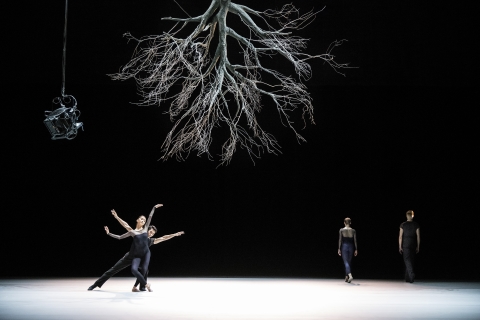Royal Opera House, Stockholm
November 14, 2018
Maggie Foyer
Like many ballet companies, the Royal Swedish is struggling to move with the times and incorporate contemporary dance into the programming while maintaining the classical repertoire. Trinity was a contemporary dance evening where the highlight was Jiří Kylián’s Wings of Wax.
The hubris of the flight of Icarus forms the background. The Greek hero aims too high, melting the wax securing his wings and plunges to his death. The myth has had numerous iterations and here it inspires Michael Simon’s enigmatic upside down tree and eternally revolving light. It has also inspired some of Kylián’s most eloquent duets in choreography of shifting emotions that fly and fall, evoking hopes and fears, love and loss.
The duets for four couples also reveal the extent of his genius as he melds movement to the concept to give underlying shades of meaning that defy the narrative label. The company fielded an excellent cast; particularly exciting was the pairing of Coralie Aulas and Calum Lowden who underscored their technical skill with just the right level of emotion. I also admired Hiroaki Ishida’s virtuosity and Minji Nam’s expressive warmth in an inspiring performance that made me wish the company did more of Kylián’s work.

Photo Sören Vilks
Angelin Preljocaj’s duet, Annonciation, opened the evening. The potent story of the angel telling Mary that she had been chosen to be the mother of Christ, has engaged artists down the centuries. To bring to life this meeting of the divine and the mortal in so personal a setting is a daunting task but it’s one the Preljocaj realises in a duet of great depth in the simplest of settings.
It offers two very desirable roles. Moe Nieda as the Angel, and Kaho Yanagisawa as Mary, took full advantage in quality performances. Together they found the emotion in intimate moments as the Angel caresses Mary’s stomach or when Mary pre-empts her divinity, imitating the motion of angel wings. Stephen Roy’s score effectively links the two worlds and builds the ambience interweaving sounds of domesticity and pregnant silences with traces of Vivaldi. It’s a beautiful work but possibly better suited to a more intimate setting.
Lukáš Timulak’s Totality in Parts was commissioned by the company and features a striking set by Peter Biľak. The opening picture catches the imagination in a symmetry of light and shape while a hanging vortex of circular wires, encrusted with lights, changes its personality throughout the work, altering the mood and the dynamics.

Photo Sören Vilks
Sadly, although Timulak has previously produced works of note, this time the choreography remains in the shadows. While he had a strong cast, and he showed skill in crafting phrases of movement, the work never seemed to find an ignition point. The action on stage struggles to match the interesting mood swings generated by the lighting, and solos, duets and ensemble sections followed one another with little clear purpose and with minimal support from the somewhat pedestrian score by Hauschka.
The new artistic director, Nicolas le Riche, seems to be continuing the pattern of exclusively ballet or contemporary programmes, rather than a mixed bill which might encourage audiences to sample the new more readily. Trinity, with an empty dark pit, and a far from full house, had little of the buzz that makes an exciting theatre experience despite the power of Kylián’s work which closed the evening. The following production will be Pär Isberg’s Nutcracker, one of the best around. This will guarantee full houses, and these audiences need to be encouraged to sample more contemporary works.

